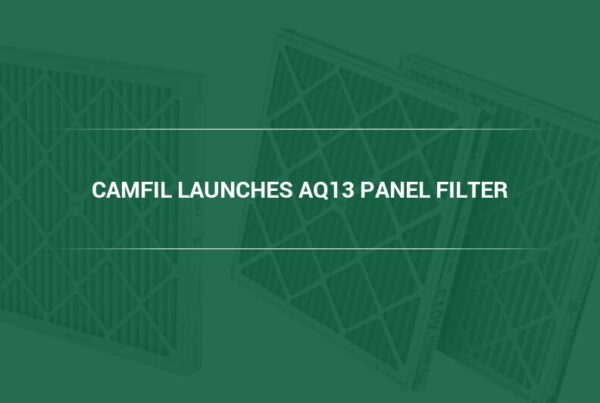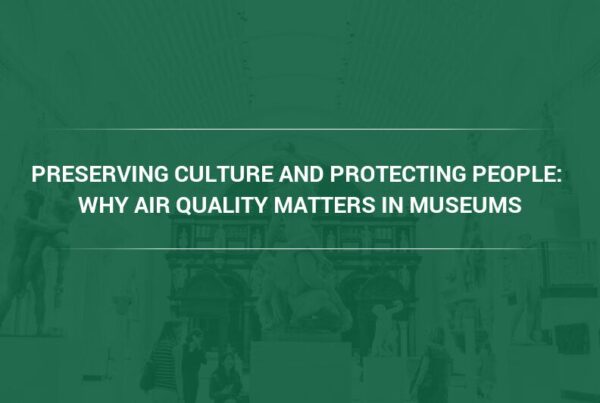Wildfires are increasingly becoming a threat not only to landscape and property but also to air quality across vast regions. While flames may burn thousands of miles away, the smoke from wildfires can significantly impact the air quality of distant communities. These traveling plumes carry harmful pollutants that degrade outdoor air and infiltrate indoor environments. As the frequency and intensity of wildfires escalate, dangers imposed on indoor air quality (IAQ) and human health have grown.
One of the most harmful byproducts of wildfire smoke is fine particulate matter. These microscopic particles are small enough to penetrate deep into the body, contributing to a range of health issues. Wildfires also release gases like carbon monoxide and volatile organic compounds, which complicate respiratory issues and contribute to ground-level ozone formation.
Smoke from the recent Canadian wildfires, for example, has spread more than 5,000 miles, reaching parts of Russia and Europe and releasing over 56 megatons of carbon. The smoke concentrations led to poor air quality across several U.S. states, including Michigan, Illinois, Iowa and Wisconsin.
High-efficiency air filtration is one essential strategy for protecting IAQ during wildfire events. Filters with higher Minimum Efficiency Reporting Value (MERV) ratings are designed to capture finer particles, significantly reducing the concentration of smoke and pollutants indoors. When paired with well-maintained HVAC systems, these filters serve as a critical defense against the serious health risks posed by wildfire smoke.
This blog article explores how climate change is driving the rise in wildfire frequency and intensity, examines environmental and health impacts, and highlights how high-efficiency air filters play a critical role in protecting IAQ.
Wildfires in the United States – Trends and Impact
Between 2013 to 2022, the U.S. averaged 61,410 wildfires annually, burning about 7.2 million acres each year. While more fires occurred annually in the 1990s (averaging 78,600 per year), the total area burned has dramatically increased. In the period between 1984 and 1993, fewer than three million acres were burned each year, while in recent years, that number has risen to more than 8 million acres annually. In 2024, approximately 8.9 million acres were scorched.
The Role of Climate Change
This surge in wildfire activity has been linked to climate change. Rising temperatures, declining snowpack, earlier snowmelt, and drier summers may be creating conditions for more frequent and severe wildfires. While many wildfires are started by humans, climate-driven conditions could fuel their intensity and scale.
Key climate-related drivers of wildfire growth include:
- Hotter temperatures that dry out vegetation, increasing flammability.
- Prolonged droughts that reduce soil and plant moisture.
- Reduced snowpack and earlier snowmelt, leading to drier landscapes in spring and summer.
- Wind shifts that accelerate the spread of fires.
- Heat-stressed forests that are vulnerable to ignition.
Longer Fire Seasons
Climate change has also increased the wildfire season length and frequency. Once largely confined to late summer and early fall, fire seasons start earlier and end later. From 1984-2002, wildfire season typically began in August. Today, it often starts as early as July and can extend into late fall and early winter.
Climate change also contributes to increased wildfire risk, size and intensity. Rising temperatures, prolonged droughts and shifts in precipitation patterns create drier landscapes, making it easier for fires to ignite, burn hotter and spread faster.
As conditions worsen, the occurrence of megafires that burn over 100,000 acres has increased. Characterized by their intensity, size, duration and scale, these exceptional fires devastate large areas. In 2021, California’s Dixie Fire burned for more than three months, scorching over 1,505 square miles and becoming one of the largest in the state’s history.
Geographic Expansion of Wildfires
While more wildfires occur in the East, larger and more destructive fires typically happen in the West. In 2022, approximately 20,000 wildfires in the western U.S. burned about 5.8 million acres. In contrast, the eastern U.S. saw around 48,000 wildfires, but these only burned 1.8 million acres.
A national wildfire risk assessment identifies California as the most at-risk state, with over 50% of its area classified at risk. The southern and southeastern US, including parts of Texas, Kentucky, Virginia, and the Appalachian states, are also facing increasing wildfire threats, with over 15% of their land considered at risk.
Smoke Travels Far and Stays Longer
Wildfire smoke can travel hundreds of miles and linger for weeks, depending on wind patterns and atmospheric conditions that can carry smoke across states, countries or even oceans. Temperature inversions can trap smoke near the ground, causing it to linger in an area for extended periods. For instance, the 2023 Canada wildfires produced thick smoke and blanketed much of the U.S. Northeast and Midwest for weeks, causing severe air quality alerts.
Economic and Environmental Consequences
Wildfires can affect individuals, businesses, governments and ecosystems in different ways:
- Destroy homes, buildings and vehicles
- Shutdown transportation networks and roadways
- Reduce worker productivity
- Increase hospitalizations
- Disrupt local economies, tourism and local businesses
- Contaminate water sources like rivers and reservoirs
- Release high amounts of carbon emissions
The 2018 wildfire season in California caused nearly $150 billion in damage, a significant portion derived from health impacts and supply chain impacts. Between 2017 and 2021, the economic loss due to wildfire damage in California reached $722 billion. As a result, many insurers have stopped writing new policies in high-risk areas of the state.
How Wildfires Affect Indoor Air Quality
Wildfire Smoke Composition
Wildfire smoke contains a complex mix of pollutants, including tiny particles and gases such as carbon monoxide, nitrogen oxides and sulfur oxides. Particle pollution, or particulate matter, is composed of tiny solid and liquid droplets suspended in air.
Fine particle pollution makes up about 90% of wildfire smoke pollutants, including:
- Fine particles: <2.5 microns (<5% of the width of a human hair)
- Ultrafine particles: <1 micron
- Coarse particles: 2.5 – 10µm
The predominance of fine and ultrafine particles poses respiratory and neurological risks and contributes to climate change due to their ability to stay airborne and travel long distances.
Indoor Penetration of Smoke
The small particles found in wildfire smoke, especially those less than 2.5microns, can easily penetrate through:
- Gaps in windows, doors, and vents
- Open windows and doors
- Poorly-sealed air conditioners
- Porous building materials, especially in older or poorly insulated buildings
- Natural ventilation systems
Once inside, poor HVAC filtration can allow these particles to accumulate, especially in tightly sealed or poorly ventilated spaces.
Ventilation is Not Enough
While ventilation is essential for maintaining healthy IAQ under normal conditions, it can worsen indoor air during wildfire events. Opening windows and relying on outdoor air can draw in unfiltered, smoky air. HVAC systems without high-efficiency filters simply recirculate contaminated air throughout a building.
Outdoor air economizers in large HVAC systems can amplify indoor smoke issues by introducing large amounts of smoke and particulate matter during wildfire seasons. Effective smoke protection combines proper filtration with controlled ventilation, not ventilation alone.
AQI vs. Indoor Conditions
The EPA created the Air Quality Index (AQI) to monitor outdoor air pollution levels. The AQI reflects the concentration of ground-level ozone, particulate matter, carbon monoxide, sulfur dioxide and nitrogen dioxide outdoors. A higher AQI indicates poorer outdoor air quality.
In contrast, IAQ refers to the quality of air inside buildings such as offices, homes and schools. Even when outdoor AQI reaches hazardous levels, indoor air can be protected if the building is well-sealed, equipped with high-efficiency particulate air (HEPA) or high-MERV filters, and if steps are taken to limit smoke from entering the building (see section 4 below).
Health Risks of Poor Indoor Air Quality During Wildfires
Wildfires pose serious health risks, not only for individuals in immediate danger zones but for communities exposed to the widespread smoke and air pollution. The microscopic particles in wildfire smoke can penetrate deep into the lungs and even enter the bloodstream. The severity of health impacts depends on exposure level, duration and individual health conditions. Both short- and long-term impacts are possible.
Short-Term Health Effects
Even brief exposure to wildfire smoke can trigger a range of symptoms.
- Eye and skin irritations
- Respiratory issues
- Asthma and COPD exacerbation
- Headaches and fatigue
- Cardiovascular effects and increased heart rate
Long-term Health Concerns
Prolonged or repeated exposure, even at moderate levels, can lead to lasting health consequences.
- Chronic respiratory conditions
- Cardiovascular disease
- Cancer risk
- Mental health issues
- Weakened immune system
Vulnerable Populations
While wildfire smoke can affect anyone, certain groups are particularly at risk:
- Children and infants
- Elderly individuals
- Pregnant people
- Individuals with asthma, COPD or heart disease
Role of High-Efficiency Air Filters in Protecting Indoor Air Quality
Understanding Filter Efficiency for Wildfire Smoke
During wildfire events, IAQ can deteriorate quickly due to the influx of fine particulate matter and toxic gases. High-efficiency filters can maintain safe indoor air. The efficiency of filters is rated by their Minimum Efficiency Reporting Value (MERV), a scale that rates filters according to their ability to trap small particles. Filters with MERV 13-16 ratings are recommended for reducing the effects of wildfire smoke on IAQ. For optimal protection, high-efficiency particulate air (HEPA) filters are the gold standard, capturing 99.97% of particles as small as 0.3 microns. Soot particles from wildfires average between 0.4 – 0.7 microns, which are easily captured by these filters.
Wildfire smoke also contains gases and odors that particle filters cannot capture. Gases are composed of particles that are so small they are more aptly referred to as molecules and can easily pass through the most efficient HEPA filters. Capturing gases requires specialized filters known as molecular filters, sometimes referred to as carbon filters. These filters remove harmful gases, VOCs and other odor-producing chemicals from the air using a filtration process known as adsorption. Identifying the gases present enables the selection of the most effective carbon media for controlling them.
Camfil USA’s Wildfire Air Quality Solutions
Residential Air Filtration Solutions
The most common temporary solution to address odor from wildfire smoke in the home or small offices is the use of CityPleat air filters, which offer 20-50% removal of common gaseous contaminants, ozone. For individual rooms, use the portable CamCleaner CC500 air purifier, which is equipped with a 99.99% HEPA filter to help control fine particulate matter.
Commercial and Industrial Applications
To effectively protect indoor environments from wildfire smoke and other airborne pollutants, Camfil recommends using a multi-stage air filtration configuration. Start with prefilters rated up to MERV 13A in the initial stage, followed by final filters reaching up to MERV 16A in the second stage. For additional protection, use a three-stage filtration system that includes HEPA filters, which would require specific frame configurations.
This strategy enhances air purification performance and improves cost efficiency. By capturing larger particles early, the final filters last longer, which reduces the frequency of replacements, minimizes energy usage, and cuts down on both maintenance and operational expenses.
Camfil air filters for wildfire smoke mitigation:
- AQ13 panel filters for single-stage units configured to hold air filters up to 4 inches in depth and supplying air to human-occupied, but non-critical spaces such as offices.
- Durafil ES3 V-bank style air filters for final filters in multi-stage units supplying air to human-occupied or production areas not requiring HEPA filtration.
- Absolute VG V-bank style filters for areas where up to 99.99% @ 0.3 micron HEPA filtration is required and the air handling unit is configured for box-style HEPA filters.
- XH Absolute filters in an all-metal frame for areas where up to 99.999% @ 0.3 micron HEPA filtration is required and the air handling unit is configured for box-style HEPA filters.
- Megalam Panel Filters for areas where panel style HEPA and ULPA (99.99% @ 0.3 micron up to 99.9995% @ MPPS) filters are required.
As wildfires become more frequent and intense, investing in high-efficiency air filters is a key component of a comprehensive air quality strategy. These systems help protect indoor air from harmful microscopic particulates, toxic gases and lingering odors, ultimately reducing both health risks and economic impacts during wildfire events.
Contact us to connect with a Camfil air filtration specialist who can help you develop a customized air quality strategy tailored to your building, people and operations.
¹ https://www.washingtonpost.com/weather/2025/06/06/canada-fires-smoke-maps/
² https://sgp.fas.org/crs/misc/IF10244.pdf
³ https://www.statista.com/topics/13062/wildfires-in-the-us/
⁴ https://www.statista.com/statistics/203990/area-of-acres-burnt-due-to-wildland-fires-in-the-us/
⁵ https://www.statista.com/topics/13062/wildfires-in-the-us/#topicOverview
⁶ https://www.epa.gov/climate-indicators/climate-change-indicators-wildfires
¹⁰ https://www.camfil.com/en-us/insights/air-quality/wildfire-smoke-filter-solution-guide
¹¹ https://learn.kaiterra.com/en/air-academy/whats-in-wildfire-smoke



